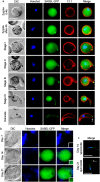SAS6-like protein in Plasmodium indicates that conoid-associated apical complex proteins persist in invasive stages within the mosquito vector
- PMID: 27339728
- PMCID: PMC4919640
- DOI: 10.1038/srep28604
SAS6-like protein in Plasmodium indicates that conoid-associated apical complex proteins persist in invasive stages within the mosquito vector
Abstract
The SAS6-like (SAS6L) protein, a truncated paralogue of the ubiquitous basal body/centriole protein SAS6, has been characterised recently as a flagellum protein in trypanosomatids, but associated with the conoid in apicomplexan Toxoplasma. The conoid has been suggested to derive from flagella parts, but is thought to have been lost from some apicomplexans including the malaria-causing genus Plasmodium. Presence of SAS6L in Plasmodium, therefore, suggested a possible role in flagella assembly in male gametes, the only flagellated stage. Here, we have studied the expression and role of SAS6L throughout the Plasmodium life cycle using the rodent malaria model P. berghei. Contrary to a hypothesised role in flagella, SAS6L was absent during gamete flagellum formation. Instead, SAS6L was restricted to the apical complex in ookinetes and sporozoites, the extracellular invasive stages that develop within the mosquito vector. In these stages SAS6L forms an apical ring, as we show is also the case in Toxoplasma tachyzoites. The SAS6L ring was not apparent in blood-stage invasive merozoites, indicating that the apical complex is differentiated between the different invasive forms. Overall this study indicates that a conoid-associated apical complex protein and ring structure is persistent in Plasmodium in a stage-specific manner.
Figures





Similar articles
-
Molecular characterization of the conoid complex in Toxoplasma reveals its conservation in all apicomplexans, including Plasmodium species.PLoS Biol. 2021 Mar 11;19(3):e3001081. doi: 10.1371/journal.pbio.3001081. eCollection 2021 Mar. PLoS Biol. 2021. PMID: 33705380 Free PMC article.
-
A SAS-6-like protein suggests that the Toxoplasma conoid complex evolved from flagellar components.Eukaryot Cell. 2013 Jul;12(7):1009-19. doi: 10.1128/EC.00096-13. Epub 2013 May 17. Eukaryot Cell. 2013. PMID: 23687115 Free PMC article.
-
Spatial localisation of actin filaments across developmental stages of the malaria parasite.PLoS One. 2012;7(2):e32188. doi: 10.1371/journal.pone.0032188. Epub 2012 Feb 28. PLoS One. 2012. PMID: 22389687 Free PMC article.
-
Basal body structure and composition in the apicomplexans Toxoplasma and Plasmodium.Cilia. 2016 Feb 4;5:3. doi: 10.1186/s13630-016-0025-5. eCollection 2015. Cilia. 2016. PMID: 26855772 Free PMC article. Review.
-
Plasmodium P47: a key gene for malaria transmission by mosquito vectors.Curr Opin Microbiol. 2017 Dec;40:168-174. doi: 10.1016/j.mib.2017.11.029. Epub 2017 Dec 8. Curr Opin Microbiol. 2017. PMID: 29229188 Free PMC article. Review.
Cited by
-
Variable microtubule architecture in the malaria parasite.Nat Commun. 2023 Mar 3;14(1):1216. doi: 10.1038/s41467-023-36627-5. Nat Commun. 2023. PMID: 36869034 Free PMC article.
-
Ancient MAPK ERK7 is regulated by an unusual inhibitory scaffold required for Toxoplasma apical complex biogenesis.Proc Natl Acad Sci U S A. 2020 Jun 2;117(22):12164-12173. doi: 10.1073/pnas.1921245117. Epub 2020 May 14. Proc Natl Acad Sci U S A. 2020. PMID: 32409604 Free PMC article.
-
The Tubulin Superfamily in Apicomplexan Parasites.Microorganisms. 2023 Mar 9;11(3):706. doi: 10.3390/microorganisms11030706. Microorganisms. 2023. PMID: 36985278 Free PMC article.
-
Cryo-tomography reveals rigid-body motion and organization of apicomplexan invasion machinery.Nat Commun. 2023 Mar 30;14(1):1775. doi: 10.1038/s41467-023-37327-w. Nat Commun. 2023. PMID: 36997532 Free PMC article.
-
Dysregulated SASS6 expression promotes increased ciliogenesis and cell invasion phenotypes.Life Sci Alliance. 2025 Aug 18;8(10):e202402820. doi: 10.26508/lsa.202402820. Print 2025 Oct. Life Sci Alliance. 2025. PMID: 40825584 Free PMC article.
References
-
- Leidel S., Delattre M., Cerutti L., Baumer K. & Gonczy P. SAS-6 defines a protein family required for centrosome duplication in C. elegans and in human cells. Nat. Cell Biol. 7, 115–125 (2005). - PubMed
-
- Nakazawa Y., Hiraki M., Kamiya R. & Hirono M. SAS-6 is a cartwheel protein that establishes the 9-fold symmetry of the centriole. Curr. Biol. 17, 2169–2174 (2007). - PubMed
Publication types
MeSH terms
Substances
Grants and funding
LinkOut - more resources
Full Text Sources
Other Literature Sources

